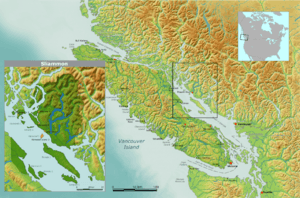Tla'amin Nation facts for kids
Quick facts for kids
Tla'amin Nation
ɬəʔamɛn
|
|
|---|---|
| Country | |
| Government | |
| • Type | Self Governing |
| Population | |
| • Total | 1,175 |
| Time zone | UTC−08:00 (PST) |
| • Summer (DST) | UTC−07:00 (PDT) |
| Postal code span |
V8A 0C4
|
| Area code(s) | Area code 604 |
| Main Office: 4779 Klahanie Drive, Powell River, British Columbia | |
The Tla'amin Nation (also known as ɬəʔamɛn in their language) is a First Nations group in Canada. They are a self-governing nation. This means they make their own decisions about their community. Their traditional lands are located on the upper Sunshine Coast in southwestern British Columbia.
The Tla'amin people are closely related to the Klahoose and Homalco peoples. They have always shared their nearby territories. In the past, these three groups, plus the K'omoks, were called the Mainland Comox. This was because they all spoke a similar language. They are part of the larger Coast Salish indigenous peoples. These groups have lived along the western coast of Canada for a very long time.
The Tla'amin territory stretches from Stillwater and northern Texada Island. It goes north along the Malaspina and Gifford Peninsulas. It reaches the southern part of Homfray Channel and a piece of Cortes Island. It also includes smaller islands like Hernando, Savary, and Harwood. Plus, it covers Powell, Goat, and Haslam Lakes.
Their old language is called ʔayʔaǰuθəm (Ay-A-Ju-Thum). The Klahoose, Homalco, and K'omoks peoples also speak this language. Long ago, the Tla'amin, Klahoose, and Homalco were one people. They had no borders between them. These three communities would spend winters together at a village called q̓aq̓ɛyq̓ay (Grace Harbour). There, they practiced special winter ceremonies. These ceremonies were important to the Coast Salish People. They included using Skway Skway masks, singing traditional songs, and performing dances. Potlatches and feasts were also common events.
Today, the main Tla'amin village is at t̓išosəm. This name means 'milky waters from herring spawn'. The Nation has over 1,100 registered members. About half of them live on Tla'amin lands. The community has been growing. It now has a new Tla'amin Governance House and a Health Centre. There is also the Ahms Tah Ow school and Chi-Chuy (a Daycare/Pre-School). The community also has two soccer fields and the Tla'amin Salish Centre. This centre is a gymnasium used as a community hall. There are also offices for the Development Corporation and more.
Contents
Tla'amin History and Culture
The Tla'amin people have lived on their lands for thousands of years. They have a deep connection to their home. This connection has helped them pass down their rich culture. This learning has gone from one generation to the next. The Tla'amin people are part of the larger Northern Coast Salish peoples. This group also includes the ƛoʔos (Klahoose), χʷɛmaɬku (Homalco), and K'omoks.
Ancient Village Sites
The Tla'amin people lived in many traditional villages. These were important places for their communities. Some of these old village sites include:
- toqʷanan - Theodosia Inlet
- toxʷnač - Okeover Inlet
- p̓aq̓iʔaǰɩm - Maple Village, Cortes Island
- ʔagayqsən - Ahgykson Island (Harwood)
- qʷoqʷnɛs - Stillwater
- χakʷum - Grief Point
- t̓atlaχʷnač - Blubber Bay
Becoming a Self-Governing Nation
In 1994, the Tla'amin Nation (then called Sliammon Indian Band) decided to start talks. They wanted to make a treaty with the Canadian and British Columbia governments. A treaty is a formal agreement. This process took 22 years for the Tla'amin Nation. Now, they are a self-governing treaty nation.
Key Steps in the Treaty Process
Here are the important dates in their journey to self-government:
- 1994: Sliammon begins the first stage of the BC Treaty Process. They submit a Statement of Intent.
- 1996: Sliammon moves into the second stage of the BC Treaty Process.
- 1996: Sliammon enters the third stage of the BC Treaty Process.
- 2001: The community votes on an agreement. This vote was very close, with 51% saying no.
- 2003: The community votes again on an agreement. This time, 63% vote yes, and it passes.
- 2011: Tla'amin, Canada, and British Columbia agree on a Final Agreement.
- June 16, 2012: An initial vote on the Final Agreement is stopped by protesters.
- March 14, 2014: The Tla'amin Final Agreement is officially approved in British Columbia. This is called royal assent.
- April 5, 2016: At midnight, the Tla'amin Nation becomes a self-governing nation. This happens when the Tla'amin Final Agreement is put into action.
The Sliammon First Nation is part of the Naut'sa mawt Tribal Council. Their main offices are in Powell River.


